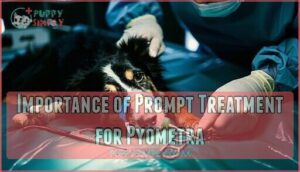This site is supported by our readers. We may earn a commission, at no cost to you, if you purchase through links.

Your dog’s size, infection severity, and location affect the price tag, but don’t let sticker shock paralyze you – waiting isn’t an option when mortality hits 100% without surgery.
Think of it as buying your pet a second chance at life, because that 4% mortality rate for treated cases beats certain death every time.
The numbers paint a clear picture, but timing makes all the difference in your dog’s outcome.
Table Of Contents
- Key Takeaways
- Pyometra Surgery: Cost and Survival Rate
- Factors Affecting Pyometra Surgery Outcomes
- Side Effects of Pyometra Surgery
- Recovery Time After Pyometra Surgery
- Life Expectancy After Pyometra Surgery
- Importance of Prompt Treatment for Pyometra
- Seeking Veterinary Attention for Sick Dogs
- Frequently Asked Questions (FAQs)
- How much does pyometra surgery cost?
- Can a dog survive a pyometra surgery?
- Can pyometra be fatal if left untreated?
- What are the long-term effects of pyometra surgery?
- What is pyometra surgery?
- What is pyometra spay surgery for dogs?
- What are the odds of survival after pyometra surgery?
- Is pyometra surgery high risk?
- Will my dog survive pyometra surgery?
- Is there any way to reduce the cost of pyometra surgery?
- Conclusion
Key Takeaways
- You’ll pay $800-$2,200 for pyometra surgery, but this cost beats the 100% mortality rate of untreated cases – don’t let sticker shock delay life-saving treatment when survival rates hit 97% with prompt action.
- Time is your enemy with pyometra – every hour counts because this infection escalates from manageable to critical within 24-48 hours, and waiting dramatically increases your dog’s risk of sepsis and organ failure.
- Your dog’s survival depends on quick recognition of symptoms – watch for lethargy, discharge, excessive thirst, or abdominal swelling, then seek emergency veterinary care immediately rather than hoping symptoms improve on their own.
- Recovery takes 2-4 weeks with proper aftercare, and most dogs return to normal, happy lives with excellent long-term outcomes – you’re essentially buying your pet a second chance at their full natural lifespan.
Pyometra Surgery: Cost and Survival Rate
When your dog faces pyometra, you’re looking at surgery costs between $500-$2,500, depending on location and emergency surgery needs.
When pyometra strikes your dog, every hour counts—but swift action saves both money and lives.
The good news is that pyometra survival rates hit 90-95% with prompt treatment, though survival factors like age and overall health matter.
Insurance coverage can help offset these expenses substantially, and treatment options focus primarily on surgical removal since medical management has lower success rates.
Don’t wait if you notice symptoms—emergency surgery dramatically improves outcomes, and most dogs return to normal, happy lives afterward.
To rule out other conditions, diagnostic imaging, including dog MRI costs, might be necessary, which can lead to a better understanding of the condition and improve overall health.
Factors Affecting Pyometra Surgery Outcomes
Your dog’s chances of surviving pyometra surgery don’t just depend on the skill of your veterinarian, though that’s certainly important.
Several key factors, including your pet’s age, overall health status, and how quickly you seek treatment, substantially influence both surgical outcomes and long-term recovery success.
Findings and Prognostic Indicators
Several survival predictors help veterinarians assess your dog’s pyometra prognosis.
Understanding these diagnostic accuracy markers can ease your worries about the procedure ahead.
Key factors affecting pyometra survival statistics include:
- Age and overall health – Younger dogs typically show better pyometra surgery success rates
- Infection severity – Open pyometra generally has lower complication rates than closed cases
- Treatment timing – Early intervention substantially improves long-term prognosis outcomes
- Pre-existing conditions – Healthy dogs face minimal recurrence risks post-surgery
These indicators guide treatment decisions effectively.
The condition is often caused by E. coli bacteria ascending into the uterus.
Owner-Reported Long-Term Outcomes
Most owners report excellent pyometra surgery success with their dogs returning to normal activities within weeks.
Post-op quality improves dramatically, with 80% experiencing no complications. You’ll likely notice positive behavioral changes as your pet feels better.
Pyometra survival rate dogs reaches 90-95%, and owner satisfaction remains high when following proper lifestyle adjustments for the best pyometra recovery rate.
This infection of the uterus is a life-threatening condition for unspayed dogs.
Surgery in a Community Medicine Setting
Good news: your local veterinary clinic can handle pyometra surgery just as effectively as expensive specialty hospitals.
Community medicine settings achieve similar survival rates while keeping pyometra surgery cost manageable for pet owners.
You don’t need to break the bank at emergency facilities when your neighborhood vet offers quality care.
Cost barriers shouldn’t prevent life-saving treatment.
Many community practices work with payment plans and focus on resource allocation that prioritizes patient outcomes over profit margins.
Ethical considerations drive these clinics to make veterinary fees accessible to everyone.
Here’s the real win: preventative spaying in community settings costs far less than emergency pyometra surgery.
Your local vet understands that community access to affordable care saves both lives and wallets.
Side Effects of Pyometra Surgery
While pyometra surgery saves lives, it carries real risks that every pet owner should understand.
Your dog faces potential complications that can extend recovery time and increase costs.
Here are the main pyometra surgery risks to watch for:
- Incision complications – Wound infections affect 3% of patients, requiring additional antibiotics and care
- Anesthesia risks – Cardiac arrhythmias occur in 1% of cases, especially dangerous for older dogs
- Post-op infection – Peritonitis develops in 13% of surgeries, potentially life-threatening
- Pain management – Adequate medication prevents suffering and promotes faster healing
Proper preparation minimizes these surgery complications substantially.
Recovery Time After Pyometra Surgery
Two to four weeks marks the typical recovery timeline after pyometra surgery, but your dog’s healing journey requires careful attention to detail.
Post-op care involves monitoring the incision site daily for redness, swelling, or unusual discharge that could signal complications. Activity restriction is essential—think of it as enforcing bedrest for someone who’d rather be running marathons.
Your pet surgery recovery success depends on following the medication schedule precisely, even when your dog seems back to normal. Nutritional support plays a pivotal role in healing, so maintain regular feeding despite potential appetite changes.
Pyometra surgery aftercare includes keeping the incision clean and dry while watching for pyometra surgery complications like excessive lethargy or vomiting. Consider post-surgery product needs to aid in your dog’s comfort.
Remember, postoperative care isn’t just following rules—it’s giving your furry friend the best shot at bouncing back stronger than ever.
Life Expectancy After Pyometra Surgery
Your dog’s long-term prognosis after pyometra surgery depends heavily on age at surgery and overall health status.
Dogs who undergo the procedure can expect to live their full natural lifespan when no severe comorbidities exist. However, breed predisposition and existing health conditions substantially impact pyometra longterm outcomes.
Many owners seek to improve their pet’s pyometra life expectancy.
Proper post-operative care plays a vital role in determining your pet’s future well-being. The pyometra survival rate dogs experience is encouraging—most achieve excellent dog pyometra prognosis with appropriate treatment, making pyometra prognosis dogs generally favorable.
Importance of Prompt Treatment for Pyometra
When facing pyometra, time isn’t just money—it’s your dog’s life.
This life-threatening infection can escalate from manageable to critical within 24-48 hours, making urgent treatment essential for survival.
Treatment delays dramatically increase mortality rates, as bacteria multiply rapidly and toxins flood your pet’s system.
Without emergency intervention, sepsis risk skyrockets, potentially causing irreversible organ damage to the kidneys, liver, and heart.
Dog pyometra survival rates drop substantially when owners wait, hoping symptoms will improve on their own.
They won’t.
Pyometra surgery becomes increasingly risky as your dog’s condition deteriorates.
What starts as a routine procedure can become a desperate fight for life if you hesitate.
Don’t let financial concerns delay action—many clinics offer payment plans, and the cost of emergency treatment far exceeds early intervention expenses.
Your quick decision-making directly impacts your dog’s chances of a full recovery.
Seeking Veterinary Attention for Sick Dogs
When something seems off with your pet, trust your instincts and seek veterinary attention immediately.
Recognizing illness early dramatically improves outcomes, especially for conditions like pyometra where emergency surgery becomes necessary. Don’t let concerns about pyometra surgery cost delay treatment—your dog’s pyometra survival rate depends on quick action.
- Emergency Signs: Watch for lethargy, discharge, excessive thirst, or abdominal swelling
- Finding Vets: Locate 24-hour emergency clinics before you need them
- Affording Care: Explore payment plans, pet insurance, or assistance programs
- Preventative Care: Regular spaying prevents pyometra entirely
Frequently Asked Questions (FAQs)
How much does pyometra surgery cost?
Nearly 1 in 4 unspayed female dogs develop pyometra before age You’ll pay between $800-$2,200 for surgery, with emergency cases costing up to $8,000 depending on your location and your dog’s condition.
Can a dog survive a pyometra surgery?
Yes, your dog can absolutely survive pyometra surgery!
With prompt treatment, survival rates reach an impressive 90-95%.
Most pets bounce back to their normal, happy selves within weeks of this life-saving procedure.
Can pyometra be fatal if left untreated?
Time is of the essence with pyometra.
Left untreated, this uterine infection rapidly becomes life-threatening, potentially causing sepsis, organ failure, and death within days.
Don’t wait—immediate veterinary intervention is critical for your dog’s survival.
What are the long-term effects of pyometra surgery?
After pyometra surgery, your dog’s long-term outlook is excellent.
Most pets experience improved quality of life with no lasting complications.
You’ll eliminate future heat cycles and pregnancy risks since the reproductive organs are removed, which can further improve your dog’s overall quality of life.
What is pyometra surgery?
Ovariohysterectomy removes your dog’s infected uterus and ovaries when she develops this life-threatening bacterial infection. The procedure’s performed under general anesthesia, taking one to two hours to complete successfully.
What is pyometra spay surgery for dogs?
When your dog’s health hangs in the balance, pyometra spay surgery removes the infected uterus and ovaries completely.
This ovariohysterectomy procedure eliminates the source of infection while preventing future reproductive complications in unspayed females.
What are the odds of survival after pyometra surgery?
Your furry friend has excellent chances of pulling through – survival rates hit 90-95% with prompt treatment.
Most dogs bounce back beautifully, though seniors or previously ill pups face slightly tougher odds.
Is pyometra surgery high risk?
While any surgery carries risks, pyometra surgery isn’t considered high-risk when performed promptly. You’re looking at a 90-95% survival rate with proper timing and veterinary care, making it relatively safe.
Will my dog survive pyometra surgery?
Yes, your dog has excellent survival chances with prompt treatment.
Most dogs recover successfully with a 90-95% survival rate when pyometra surgery happens quickly, making this procedure highly effective and reliable.
Is there any way to reduce the cost of pyometra surgery?
Several options can help lower your costs.
Look into low-cost spay clinics offering reduced rates, explore pet insurance covering up to 80% of expenses.
Or seek donations from organizations like PAL for financial assistance.
Conclusion
Knowledge becomes your greatest weapon when facing pyometra surgery cost and survival rate decisions.
You’ve learned that $800-$2,200 represents a small price for your dog’s life, especially with 97% survival rates when treatment begins promptly.
Don’t let financial concerns cloud your judgment—untreated pyometra guarantees tragedy, while surgery offers hope.
Time remains your enemy, so recognize symptoms early and act decisively.
Your veterinarian can discuss payment options, but your dog’s survival depends on swift action, not perfect timing.
- https://www.avma.org/javma-news/2001-10-15/nonspaying-linked-health-problems-female-pets
- https://www.ncbi.nlm.nih.gov/pmc/articles/PMC6940821/
- https://www.vetmed.ucdavis.edu/hospital/animal-health-topics/pyometra
- https://www.metlifepetinsurance.com/blog/pet-planning/neuter-spay-dog-cost/
- https://www.northshorehumane.org/pyo-what-what-if-simple-surgery-could-prevent-life-threatening-situation-occurring-your-pet













